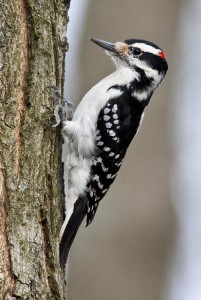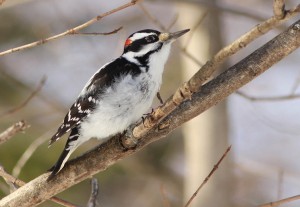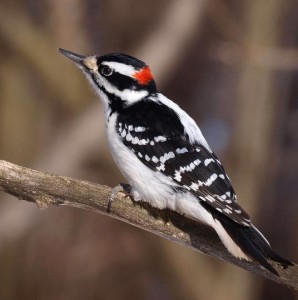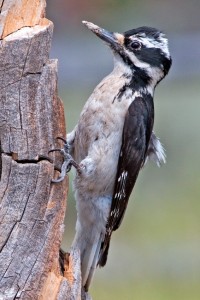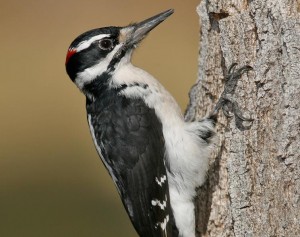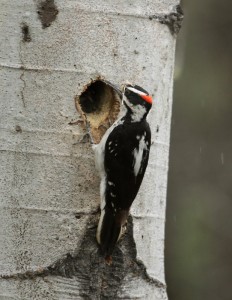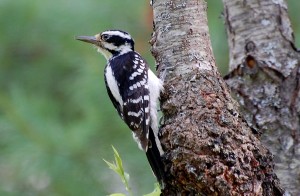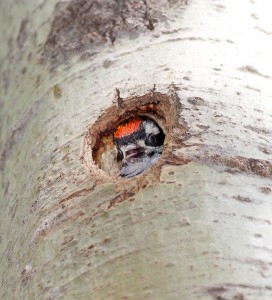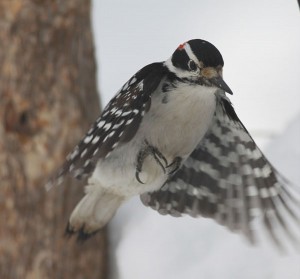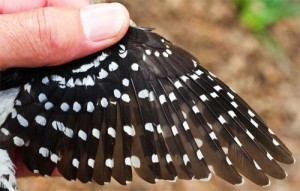Hairy Woodpecker
The hairy woodpecker is a small- to medium-sized bird found in the high mountain forests of Central America, as well as both the plains and the mountainous regions of North America. It is a powerful bird for its size, often seen foraging along the branches and tree trunks. Though it has some striking similarities with the downy woodpecker, it has a much larger structure and its bill is longer as compared to the thornlike bill of the downy.
Scientific Classification
| Kingdom | Animalia |
| Phylum | Chordata |
| Class | Aves |
| Order | Piciformes |
| Family | Picidae |
| Genus | Picoides |
| Scientific Name | Picoides villosus |
Quick Information
| Other Names | Carpintero-velloso mayor (in Spanish), Pic chevelu (in French) |
| Size | 7.1-10.2 inches (18-26 cm) |
| Wingspan | 13-17 inches (33-43 cm) |
| Weight | 1.4-3.4 ounce (40-95 gram) |
| Color | Combination of black and white with variable white markings on the black wings, two white streaks on the head, a long white patch at the back; the males have a red bar at the back of the neck |
| Distribution | Canada, the United States, Mexico, Costa Rica, Guatemala, El Salvador, Honduras, Bahamas, Puerto Rico, Panama, Turks, and Caicos Islands |
| Habitat | Mature deciduous forests; also seen in parks, suburbs, open oak and pine woodlands, forest edges, burned-out forests |
| Sound/Song | The sharp pee-ik or peek call is common, but unlike the downy’s it is lower pitched; the rattle call or the whinny comprises of a fast and descending series of peek calls; the drum call is a series of rapidly reverberating beats |
| Lifespan | About 15 years (in the wild) |
| Diet | Eats larvae of insects like ants, bark beetles, and wood-boring beetles; also feeds on millipedes, spiders, wasps, bees, caterpillars, grasshoppers, and cockroaches but to a smaller extent; seen eating fruits, seeds, nuts, and suet during winter |
| Adaptations | A powerful bill to excavate and drill into tree barks; stiff tail feathers used as a support for moving along a tree trunk; a long tongue with backward facing barbs and coating of sticky saliva to get the wood-boring insects out from their tunnels |
| Migration | Mostly resident birds; some birds may move away from the north during winter; those breeding at higher elevations sometimes travel to the coastal areas during winters |
| Size of Clutch | 3 to 6 eggs |
| Egg Size | Length: 2.1-2.5 cm
Width: 1.8-1.9 cm |
| Number of Broods | Single brood a year |
| Incubation Period | 11 to 14 days |
| Predation and Competition | From European Starling, Red Squirrel, and Raccoon |
| IUCN Conservation Status | Least Concern |
Behavior
The hairy woodpeckers use both their feet simultaneously to pull themselves up the main tree trunk and large branches. They sometimes feed at the foot of trees, specifically pine trees that are often infested with bark beetles.
These birds display aggression by directing their bills, raising and turning their heads, raising their crests, and spreading their wings. During conflicts, they raise their wings at an angle of 45° and stretch out their heads uttering a series of sharp smacking wad and twitter calls.
Mating and Reproduction
In early winter, the male and female hairy woodpeckers maintain different territories. They start displaying courtship in mid-winter when the male uses a drumming call to attract a female. The interested female will usually respond back with a drumming sound. After forming a pair, the courting birds engage in bill pointing, head bobbing, neck stretching, and wing-flicking.
Their breeding season starts in February and ends in June. Both the sexes take part in excavating cavities in dead conifers, aspens, and deciduous trees, usually at a height of 4 to 60 feet from the ground. They use these nesting sites for raising their chicks.
Life Cycle
After laying a clutch of all white eggs, the female starts incubating during the day, whereas its male partner incubates at night. The hatchlings emerge from their shells after about 14 days of incubation. The young birds are fed by both the parents, with the males wandering away from the nest in search of food. The juvenile birds are ready to fledge after a month of hatching. However, they remain under the care of their parents for another two weeks before reaching their independence.
Interesting Facts
- These woodpeckers often feed on leaking sap from the holes that are punctured in tree trunks by sapsuckers.
- A hairy woodpecker may follow a pileated woodpecker, explore the cavities that the pileated has excavated, and prey upon any insect that the latter had failed to capture.
References
- http://www.allaboutbirds.org/guide/ Hairy_Woodpecker/id
- https://en.wikipedia.org/wiki/ Hairy_woodpecker
- https://www.nationalgeographic.com/animals/birds/facts/hairy-woodpecker
- https://www.audubon.org/field-guide/bird/hairy-woodpecker
- https://www.nps.gov/miss/learn/nature/birdshair.htm
- http://animaldiversity.org/accounts/ Picoides_villosus/
Published on September 30th 2015 by admin under Coniferous Forest Animals.
Article was last reviewed on 5th December 2024.


